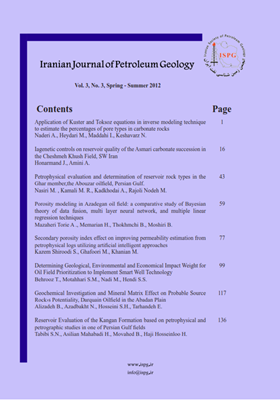Reservoir Evaluation of the Kangan Formation based on petrophysical and petrographic studies in one of Persian Gulf fields
Subject Areas :سید نظام الدین طبیبی 1 , حسین اصیلیان مهابادی 2 , بهرام موحد 3 , حسن حاجی حسنلو 4
1 -
2 -
3 -
4 -
Abstract :
The Early Triassic Kangan Formation is the main reservoir in the Persian Gulf. In this study reservoir rock types were recognized according to lithology, rock fabric, geometry and amount of porosity. Therefore, 7 reservoir rock types were determined: - Anhydrite without reservoir quality, - limy– dolomite with mud dominated fabric without reservoir quality, - limy– dolomite with mud dominated fabric and an average reservoir quality, -limy– dolomite with mud dominated fabric and good reservoir quality, - dolomite with crystalline fabric and low reservoir quality, - limestone with grain dominated fabric with an average reservoir quality and - dolomite with crystaline fabric with a good reservoir quality. Based on petrophysical logs(Gamma ray, sonic, neutron & density), 5 reservoir units and 6 non – reservoir units were identified. Reservoir units are mainly formed of porous grain dominated limestone ,crystalline dolomite and mud dominated fabric dolomite, and non – reservoir units include anhydrite and limy dolomite without porosity. Petrophysical and petrographical studies indicate that moldic, intercrystaline and interparticle porosities are the most effective porosities in the reservoir units of this formation, whereas others like vuggy , fracture and intraparticle porosities have minor role in reservoir quality.


